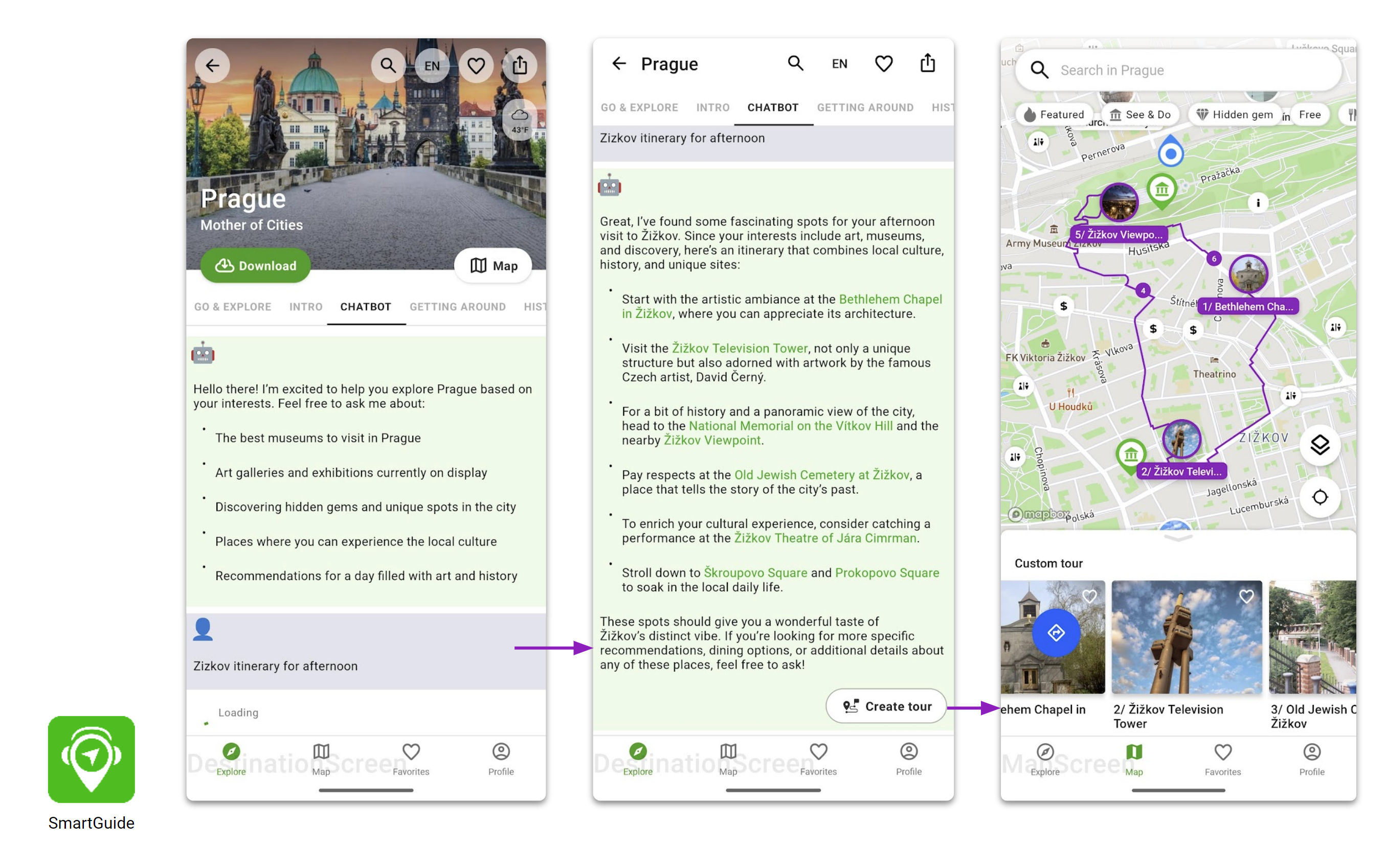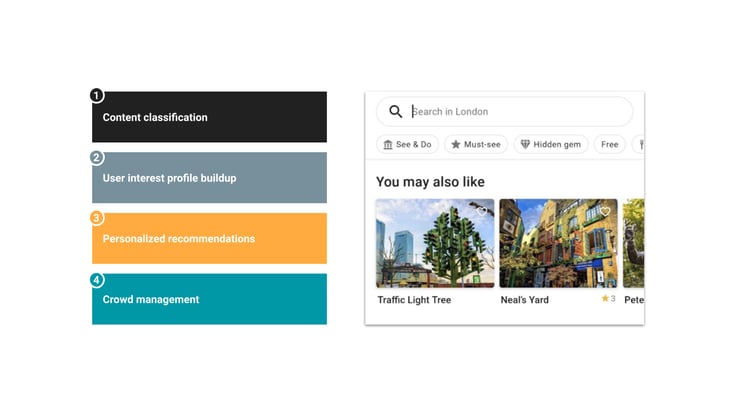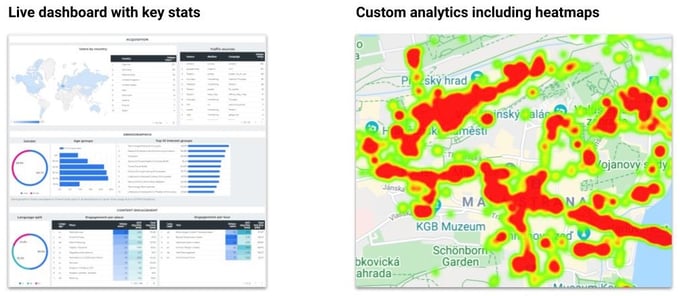The tourism industry is undergoing rapid shifts, fueled by digitalization. As travel becomes more...
Key trends shaping tourism industry in 2024
The upcoming year in the tourism industry is set to be influenced by unprecedented technological shifts, and a push for an authentic, transformative, and environmentally conscious journey.
Let's explore the key tourism industry trends of 2024, providing insights to stakeholders who are keenly observing how these challenges will influence their strategies as well as the ever-growing demands of the modern traveler.

1. Adoption of artificial intelligence in travel content creation
The tourism industry is witnessing a considerable move towards the adoption of artificial intelligence (AI) thanks to recent developments and increased accessibility of large language models and tools such as ChatGPT.
National and regional tourism boards, destination management organizations (DMOs), tourist attractions, museums, and tourism businesses in general stand to gain considerably from embracing AI developments. Today's travelers, growing accustomed to the convenience and efficiency of AI, expect similar experiences from services and content provided by tourist destinations.
AI chatbots for itinerary planning and personalized recommendations
The era of wiki-style text information and analog interfaces is fading; travelers now seek engaging, authentic, and compelling content. For DMOs and tourist attractions, it means they need to work on improving and ramping up their content and digitizing their service to keep pace.
Generative AI tools like the above-mentioned ChatGPT, which had a 6% global usage rate among travelers in 2023, are expected to gain wider acceptance in 2024, with half of those surveyed showing interest in using these tools for planning their trips.
 Preview of a currently developed new AI chatbot for creating accurate and engaging custom itineraries within the SmartGuide app
Preview of a currently developed new AI chatbot for creating accurate and engaging custom itineraries within the SmartGuide app
These AI tools streamline the travel planning process as well, with 40% of travelers expressing interest in using them to find ideal accommodations, for example. The trend extends beyond pre-visit planning, with AI chatbots offering real-time assistance, thereby improving visitor services while reducing costs.
AI-powered recommendations for travelers
By analyzing data from traveler's past experiences, interests, and real-time activity, AI can also suggest attractions and places that align with their tastes. This personalized approach not only enhances the traveler's experience, but it also creates opportunities for DMOs and tourism businesses to upsell and cross-sell their services.
For example, if a visitor has shown interest in local art, an AI system can recommend the best museums or exhibitions that would align with this interest. This form of highly targeted content personalization can significantly increase user engagement and satisfaction, ultimately leading to a boost in the local tourism economy.
These AI-powered personalized recommendations, already commonplace in the retail and entertainment sectors, are set to become an integral part of the travel industry in 2024, delivering a seamless, and enriching travel experience.
 SmartGuide's AI recommendations
SmartGuide's AI recommendations
AI-powered CMS systems
Destinations and tourism businesses can benefit from AI advancements in content creation too, such as by using AI-powered content management systems for itineraries and guide content creation for their visitors. AI-based translation tools such as DeepL, which can be built into these content platforms, effectively eliminate language barriers and enable seamless communication with various audiences of visitors.
Digital travel guide platforms like SmartGuide offer these features in their content management system and facilitate tourism entities in tailoring content to meet the rising demands of travelers on scale. AI has also immensely sped up the process of audio generation from the existing text content. These text-to-speech technologies deliver audio resembling human speech in milliseconds, positively changing the creation of digital audio guides, for instance.
Verification of AI-generated content
AI content verification will become more prevalent. Platforms like YouTube, Meta, X, and others are expected to aggressively implement “AI content tagging” systems in 2024. In the travel industry, the SmartGuide platform already has this verification in place, and it visibly tags its AI-generated content as being authored by "SmartGuide AI".
2. Increased Augmented Reality adoption across the tourism industry
Another stirring tourism industry trend in 2024 is the increasing integration of Augmented Reality (AR) into traveling exposure. In 2021, the AR market was valued at $8.6 billion, and it's projected to grow at a compound annual growth rate of 38% by 2030.
This growth isn't just confined to the tech or gaming industries; it's making a great impact on the tourism sector as well. According to a Kantar study commissioned by Snapchat, up to 93% of travelers said they would use augmented reality at least one point in their trip in the future.
This swift adoption is fueled by a convergence of factors: heightened consumer interest in engaging adventures, progress in AR technology making it more user-friendly and economical, and the rise of solutions that streamline AR integration for destination management organizations (DMOs) and tourism businesses. Companies like Wikitude, HiVu, and Echo3D, for example, specialize in developing AR models. Additionally, digital audio guide platforms like SmartGuide can host and publish AR models for destinations and tourist attractions, making the process less complex. Additionally, even without a fancy AR model, destinations and attractions can create engaging AR experiences - the only thing they need is an authentic historical photo, which can also be turned into an AR object on SmartGuide, making the implementation of AR a lot easier.

A geolocated image or video blends history into the present when viewed at the place of interest.
3. Open data projects enabling digitalization of the tourism industry
In 2024, the push for digitalization will drive an increase in open data projects. Governments and industries globally are investing heavily in these complex initiatives to facilitate the transition towards more digitized infrastructure.
A prime example of this is the establishment of the German Knowledge Graph (GKG), a comprehensive open data project that serves as a vital resource for various applications within the tourism industry. The Knowledge Graph, now live, provides all stakeholders - including global sales platforms, tourism service providers, start-ups, or digital platforms - access to over 200,000 current, high-quality data sets freely available for download. As it stands, these data sets include 100,000 tourism assets (such as Points of Interest, tours, events, restaurants, cafes, hotels, etc.) and an additional 100,000 essential infrastructure elements. Sourced from all 16 federal states, the Knowledge Graph acts as Germany’s tourism industry's central database. For example, by tapping into this vast network of data, travel apps and software can build upon accurate content that enhances the relevance and adaptability of the journey.

Knowledge Graph, Source: open-data-germany.org
4. Surge in online bookings and push for digital interfaces
Online and app bookings, although not new, are poised to see a noteworthy surge in the coming years. In fact, the online travel booking market, which had a worth of $432 billion in 2020, is projected to nearly double by 2025, reaching an estimated value of $833 billion. This rapid expansion emphasizes the importance of relevant presence where visitors are actively searching for their travel destinations.
A key aspect of this transformation is the escalation in mobile bookings. It is estimated that about 70% of travelers use their smartphones to book holidays. Furthermore, 72% of these mobile bookings occur within two days of conducting a Google search. This indicates a short window from search to booking, presenting both challenges and opportunities for destinations. Therefore, it's essential for DMOs and tourism boards to proactively maintain their online presence and image. This includes ensuring their visibility on various portals like TripAdvisor, Expedia, or SmartGuide. A robust online ecosystem, responsive strategies for reviews, and up-to-date attractive content are key elements that can influence a traveler's decision. For destinations and travel businesses, this means it's not just about reaching potential visitors through their mobile devices, but also about crafting and maintaining engaging and high-quality online interfaces and content on different forums that capture visitors' attention.
In essence, the inclination towards digital interfaces allows DMOs and travel business owners to reach a wider, digitally-savvy audience. On the other hand, it necessitates the need to invest in efficient booking tools and processes that can handle the increasing volume of online and app bookings for tourism in 2024.
5. Establishing new goals and actions for more sustainable tourism
One of the prominent more long-term transitions is towards sustainable travel which can also be seen in 2023. This trend has been driven by a growing realization of the importance of eco-friendly travel practices, especially in response to recent world events and policy changes.
In 2023, several important events and legislation set the stage for this shift. For example:
- The EU Green Deal Destination Certification launch was a notable event that established environmental stewardship objectives for tourist destinations, with the first certifications expected to be awarded in 2024.
- The World Travel & Tourism Council Global Summit 2023 focused on the role of conservation techniques in the future of travel.
- The announcement of the 2023 Global Destination Sustainability Index results played a crucial role in setting new standards for sustainable methods in the tourism industry.
- The inaugural celebration of World Sustainable Transport Day emphasized the importance of ecologically sound transportation.
- Island nations implemented stricter environmental regulations for tourism activities in 2023, such as marine protected areas and coral reef conservation measures. These trends are likely to continue in 2024, with even stricter regulations aimed at protecting fragile ecosystems.

The importance of eco-friendly practices is evident in the increasing emphasis on responsible travel. The influence of slowed-down world trade and landmark legislation on green tourism is vital, with 59% of travelers expressing a desire to leave the places they visit better than when they arrived. Furthermore, 33% revealed that they chose to travel outside of peak season to avoid overcrowding, and nearly a quarter (23%) opted to travel to a destination closer to home over the last 12 months to reduce their carbon footprint. These decisions reflect a transference toward more mindful and conscious travel picks, indicating the impact of global variations and policy movements.
When it comes to reducing overcrowding, digital audio guides such as SmartGuide can contribute to eco-friendliness by promoting self-guided tours that dispense crowds to lesser-known spots.
In this context, another implication is the resurgence of train travel which is influencing destination planning and service provision. As highlighted by OAG, climate change has become an increasingly major issue, prompting many visitors to reconsider their transportation choices. Many travelers are shifting from air to rail, which offers a greener alternative. This requirement has prompted enhanced investment in rail infrastructure, including the development of new stops and stations, as well as upgrades to existing facilities. As a result, train journeys have become more efficient and appealing.
6. Post-pandemic effects in 2024 - Embracing bleisure and uncharted explorations
Two major trends emerging for tourism in 2024 are bleisure travel and off-the-beaten-path exploration, partially as post-effects of the COVID pandemic.
Bleisure travel, a novel fusion of business and leisure, has seen a surge due to the rise of remote work. Individuals are extending their business trips to include personal vacation time, a trend accelerated by the pandemic-induced shift to remote work. This newfound freedom, untethered from specific geographic locations, has enabled travelers to explore new destinations while still fulfilling their professional responsibilities. The trend is not just a fad; it's a noteworthy pattern impacting the tourism sector, leading to increased hotel occupancy rates, and average daily rates, and stimulating local economies.
Furthermore, during the two years of isolation, a longing for unique experiences has prompted travelers to seek out hidden gems, steering clear of overcrowded and popular tourist spots. This growing interest in off-the-beaten-path travel is reshaping the tourism landscape, with travelers seeking authentic cultural experiences in less explored regions. This trend signifies a societal switch towards valuing authenticity and personal growth during travel. It involves engaging with local communities, understanding their traditions, tasting regional cuisines, and gaining insights into their way of life.
7. Personalization of offerings for travelers through big data
There is a delicate balance between the demand for personalized services and the growing need for data protection. Tourists are seeking personalized products that cater to their specific preferences, but this personalization is made possible through the collection and analysis of vast amounts of data generated by the tourists' activities (mainly online). However, there is a strong consumer push to reduce the means of collecting data that pertains to personal matters.
To reconcile these two seemingly contradicting forces, various services use aggregated and anonymized data. This approach respects individual data protection rights while still enabling the delivery of personalized content to specific audiences and consumer personas.
DMOs are also increasingly using big data dashboards for data-driven management, and real-time information to make informed decisions and provide better services. This trend is expected to accelerate in 2024, with subjects in the tourism industry using big data to uplift visitors’ traveling while respecting data protection regulations.

Big data dashboards and a destination heatmap of travelers' engagement by SmartGuide.
Conclusion
The tourism industry trends in 2024 reflect a substantial transition toward adoption of the AI, digitization, personalization, and sustainability. The incorporation of AI and AR technologies, the increase in online bookings, and the focus on green environment practices illustrate the dynamic nature of the industry. Additionally, the growing popularity of bleisure travel and off-the-beaten-path destinations as the post-pandemic impact underscores the evolving preferences of travelers. Overall, the future of travel promises exciting turns, with digital platforms like SmartGuide at the forefront, ready to adapt and innovate to augment the travel experience for all.
Be at the forefront of 2024's tourism evolution with AI, AR, and sustainable tourism practices.
Not sure where to start? Implementing a digital travel guide is a good first step.
.png?width=300&height=69&name=Logo%20SmartGuide%20horizontal%20(1).png)
.jpg?width=536&height=301&name=CTA%20banners%20for%20SMG%20blog%20(5).jpg)


